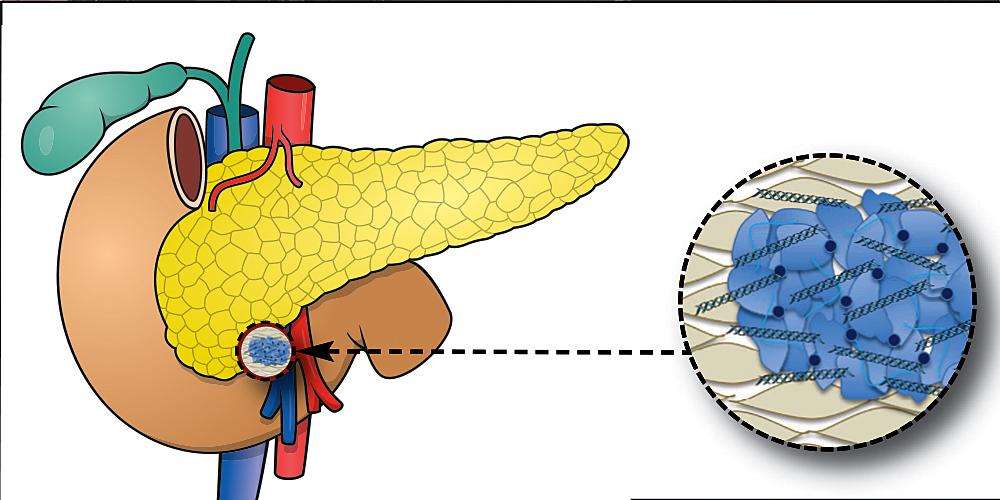What is the difference between stroma and parenchyma? These terms may sound unfamiliar, but they are fundamental to understanding the structure and function of tissues and organs. Stroma and parenchyma are two key components that work together to create the complex architecture of our bodies.
Imagine a city. The stroma is like the infrastructure, the roads, bridges, and utilities that support the city’s function. The parenchyma is like the buildings, businesses, and residents that carry out the city’s activities. Both are essential for the city to thrive. Similarly, in the body, the stroma provides the framework and support, while the parenchyma carries out the specialized functions of the organ.
Introduction to Stroma and Parenchyma

The terms stroma and parenchyma are fundamental concepts in biology, particularly in the study of tissues and organs. Understanding these terms is crucial for comprehending the intricate organization and functional specialization within various parts of the body.Stroma and parenchyma are two distinct components that work together to create the complex architecture of tissues and organs. They are like the foundation and the building blocks of a structure, each playing a vital role in its overall function.
Stroma
Stroma, derived from the Greek word “στρῶμα” (strōma) meaning “bedding” or “layer,” refers to the supporting framework or connective tissue of an organ or tissue. It acts as the scaffolding that provides structural support and organization to the functional cells.Stroma is typically composed of:
- Connective tissue: This includes fibrous proteins like collagen and elastin, which provide strength and flexibility, and ground substance, a gel-like material that fills the spaces between cells.
- Blood vessels: These are essential for supplying nutrients and oxygen to the parenchyma and removing waste products.
- Nerves: These transmit signals to and from the parenchyma, enabling communication and coordination within the organ.
The stroma’s role is not limited to structural support. It also contributes to the overall function of the organ by:
- Providing a physical barrier: The stroma helps to compartmentalize different tissues within an organ, creating distinct regions with specific functions.
- Facilitating communication: The stroma serves as a pathway for the diffusion of molecules, allowing for communication and exchange between different parts of the organ.
- Supporting cell growth and differentiation: The stroma can provide signals that influence the development and differentiation of parenchyma cells.
Parenchyma
Parenchyma, derived from the Greek word “παρέγχυμα” (parénchyma) meaning “to pour in beside,” refers to the functional cells of an organ or tissue. These cells are responsible for the specific activities of the organ, carrying out the primary functions that define its role in the body.The specific types of cells found in the parenchyma vary depending on the organ. For example, the parenchyma of the liver consists of hepatocytes, which are responsible for detoxification and protein synthesis.
The parenchyma of the lungs contains alveoli, which are responsible for gas exchange.The parenchyma’s primary function is to:
- Carry out the specific functions of the organ: This can include secretion, absorption, filtration, and other specialized activities.
- Maintain the organ’s structure: The parenchyma cells can contribute to the overall shape and organization of the organ.
- Regulate the organ’s function: The parenchyma cells can respond to signals from the environment and other parts of the body, adjusting the organ’s activity as needed.
Structural Differences
Stroma and parenchyma are two fundamental components of many organs and tissues, playing distinct roles in their overall structure and function. Understanding their structural differences is crucial for appreciating the complexity and diversity of biological systems.
Structural Characteristics of Stroma and Parenchyma
The structural characteristics of stroma and parenchyma are significantly different, reflecting their contrasting roles in the organ or tissue.
- Stroma: The stroma acts as a supporting framework, providing structural integrity and organization. It is typically composed of connective tissue, which includes various cell types, such as fibroblasts, collagen fibers, and elastin fibers. The stroma also contains blood vessels and nerves, which supply nutrients and oxygen to the parenchyma and facilitate communication within the organ.
- Parenchyma: The parenchyma represents the functional part of the organ or tissue, carrying out the specific activities for which the organ is designed. It is composed of specialized cells, often arranged in a particular pattern, that perform the primary function of the organ. For example, the parenchyma of the liver consists of hepatocytes, which are responsible for detoxification and protein synthesis.
Key Cell Types and Components
The specific cell types and components present in stroma and parenchyma vary depending on the organ or tissue.
- Stroma: The stroma is characterized by the presence of connective tissue cells, including fibroblasts, which produce collagen and elastin fibers. These fibers provide strength and elasticity to the stroma, supporting the parenchyma and maintaining the organ’s shape. Additionally, the stroma contains blood vessels, which transport nutrients and oxygen to the parenchyma, and nerves, which transmit signals within the organ.
- Parenchyma: The parenchyma is composed of specialized cells that perform the organ’s primary function. For example, the parenchyma of the kidney contains nephrons, which are responsible for filtering blood and producing urine. In the lungs, the parenchyma is made up of alveoli, which are tiny air sacs where gas exchange occurs.
Examples of Specific Tissues and Organs
The structural differences between stroma and parenchyma are evident in various tissues and organs.
- Liver: The liver parenchyma is composed of hepatocytes, which are arranged in plates and perform detoxification and protein synthesis. The stroma of the liver consists of connective tissue, including collagen fibers and blood vessels, which provide structural support and supply nutrients to the hepatocytes.
- Lung: The lung parenchyma is made up of alveoli, which are tiny air sacs where gas exchange occurs. The stroma of the lung consists of connective tissue, including collagen fibers and elastin fibers, which provide structural support and allow the lungs to expand and contract during breathing.
Functional Differences: What Is The Difference Between Stroma And Parenchyma
The functional differences between stroma and parenchyma are fundamental to the proper functioning of tissues and organs. While the parenchyma performs the primary functions of the tissue or organ, the stroma provides essential support, protection, and regulation.
Stroma and Parenchyma in Various Tissues and Organs
The roles of stroma and parenchyma vary across different tissues and organs.
- In the liver: The parenchyma consists of hepatocytes, which are responsible for the liver’s metabolic functions, including detoxification, protein synthesis, and bile production. The stroma, composed of connective tissue, provides structural support and contains blood vessels that deliver nutrients and oxygen to the hepatocytes and remove waste products.
- In the kidney: The parenchyma includes nephrons, the functional units of the kidney responsible for filtering blood and producing urine. The stroma, containing blood vessels, nerves, and connective tissue, supports the nephrons and helps regulate blood flow.
- In the lungs: The parenchyma consists of alveoli, the tiny air sacs where gas exchange occurs. The stroma, composed of connective tissue and smooth muscle, provides structural support and allows for the expansion and contraction of the lungs during breathing.
- In the brain: The parenchyma consists of neurons and glial cells, responsible for information processing and transmission. The stroma, composed of blood vessels and connective tissue, provides support and protection for the delicate brain tissue.
Specific Roles of Stroma and Parenchyma
The stroma plays a crucial role in supporting, protecting, and enabling the function of the parenchyma:
- Structural Support: The stroma provides a framework for the parenchyma, maintaining its shape and organization. For example, the connective tissue in the stroma of the liver helps maintain the liver’s structure and prevents it from collapsing under its own weight.
- Protection: The stroma acts as a barrier against physical damage and infection. For example, the connective tissue in the stroma of the skin helps protect the underlying tissues from injury and infection.
- Regulation: The stroma plays a role in regulating the function of the parenchyma. For example, the blood vessels in the stroma of the kidney regulate blood flow to the nephrons, ensuring proper filtration and urine production.
- Nutrient and Waste Exchange: The stroma contains blood vessels and lymphatic vessels that transport nutrients and oxygen to the parenchyma and remove waste products. This is essential for the proper functioning of the parenchyma.
Summary of Functional Differences, What is the difference between stroma and parenchyma
The following table summarizes the key functional differences between stroma and parenchyma:
| Feature | Stroma | Parenchyma |
|---|---|---|
| Function | Support, protection, regulation, nutrient and waste exchange | Primary function of the tissue or organ |
| Examples | Connective tissue, blood vessels, nerves | Hepatocytes (liver), nephrons (kidney), alveoli (lungs), neurons (brain) |
| Role in tissue function | Provides framework, protection, and regulation for the parenchyma | Performs the specific tasks of the tissue or organ |
Examples in Different Organs

The distinction between stroma and parenchyma becomes clearer when we examine specific organs. These two components work together to ensure the proper functioning of each organ, with the stroma providing essential support and the parenchyma carrying out the organ’s primary function.
Stroma and Parenchyma in Various Organs
The following table illustrates the differences between stroma and parenchyma in various organs:
| Organ | Stroma Description | Parenchyma Description | Functional Relationship |
|---|---|---|---|
| Liver | Connective tissue framework, including blood vessels, lymphatic vessels, and bile ducts. | Hepatocytes (liver cells) responsible for detoxification, protein synthesis, and bile production. | The stroma provides a structural framework for the liver, allowing for the proper arrangement and function of hepatocytes. It also facilitates the transport of blood, lymph, and bile, essential for liver function. |
| Kidney | Connective tissue, blood vessels, and the renal capsule. | Nephrons, the functional units of the kidney, responsible for filtering waste products from the blood and producing urine. | The stroma provides structural support for the nephrons and facilitates the flow of blood and urine through the kidney. |
| Lungs | Elastic connective tissue, blood vessels, and airways. | Alveoli, tiny air sacs responsible for gas exchange between the air and blood. | The stroma provides a flexible framework for the lungs, allowing for expansion and contraction during breathing. It also supports the blood vessels and airways, ensuring efficient gas exchange. |
Clinical Significance

Understanding the differences between stroma and parenchyma is crucial in clinical settings, as it helps in comprehending organ function, disease development, and treatment strategies. Alterations in either stroma or parenchyma can significantly impact organ function, leading to various diseases.
Impact of Stroma Alterations on Organ Function and Disease Development
Stroma alterations can directly affect organ function and disease development. For instance, changes in the extracellular matrix, a key component of stroma, can lead to:
- Increased stiffness: This can impair tissue regeneration and contribute to fibrosis, a condition where excessive scar tissue replaces normal tissue. Fibrosis can occur in various organs, including the liver, lungs, and kidneys, leading to impaired function.
- Altered cell signaling: The extracellular matrix plays a role in cell communication and signaling. Changes in its composition can disrupt these signals, leading to abnormal cell growth and development, potentially contributing to cancer.
- Inflammation: Stroma can be a site of inflammation, attracting immune cells and contributing to tissue damage. This can be observed in chronic inflammatory diseases like rheumatoid arthritis, where inflammation in the joint stroma leads to cartilage and bone erosion.
Impact of Parenchyma Alterations on Organ Function and Disease Development
Parenchyma alterations can directly impact organ function and disease development. For example, changes in the functional cells of the parenchyma can lead to:
- Loss of function: This can occur in diseases like Alzheimer’s disease, where neuronal loss in the brain parenchyma leads to cognitive decline.
- Abnormal function: This can occur in diseases like diabetes, where pancreatic beta cells in the parenchyma are damaged, leading to insulin deficiency and hyperglycemia.
- Increased proliferation: This can occur in cancer, where uncontrolled cell growth within the parenchyma leads to tumor formation and spread.
Examples of Diseases Targeting Stroma or Parenchyma
- Stroma-targeting diseases:
- Fibrosis: This condition affects various organs, including the liver (cirrhosis), lungs (pulmonary fibrosis), and kidneys (glomerulosclerosis), and is characterized by excessive scar tissue formation in the stroma, leading to organ dysfunction.
- Scleroderma: This autoimmune disease affects the skin and internal organs, characterized by excessive collagen deposition in the stroma, leading to thickening and hardening of tissues.
- Parenchyma-targeting diseases:
- Cancer: This disease is characterized by uncontrolled cell growth within the parenchyma, leading to tumor formation and spread. Different types of cancer target specific parenchyma, such as lung cancer affecting lung parenchyma and breast cancer affecting breast parenchyma.
- Inflammatory bowel disease: This condition affects the gastrointestinal tract, characterized by inflammation and damage to the intestinal parenchyma, leading to symptoms like diarrhea, abdominal pain, and bleeding.
Understanding the difference between stroma and parenchyma is crucial for comprehending how tissues and organs function, how they develop, and how they can be affected by disease. By appreciating the intricate interplay between these two components, we gain a deeper insight into the complexities of our own bodies.
FAQ Section
What are some examples of diseases that affect the stroma?
Diseases like fibrosis, which involves excessive scar tissue formation, can significantly impact the stroma. This can disrupt organ function and lead to complications.
What are some examples of diseases that affect the parenchyma?
Parenchyma can be affected by a wide range of diseases, including infections, cancers, and degenerative disorders. For example, pneumonia is an infection that primarily affects the parenchyma of the lungs.
Can the stroma and parenchyma be affected by the same disease?
Yes, many diseases can affect both the stroma and parenchyma. For example, in liver cirrhosis, both the liver’s parenchyma and stroma are damaged, leading to scarring and dysfunction.
Why is it important to distinguish between stroma and parenchyma in medicine?
Understanding the differences between stroma and parenchyma is essential for diagnosing and treating diseases. It helps clinicians to pinpoint the specific tissues affected and to develop targeted therapies.






